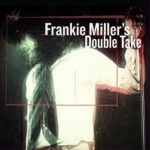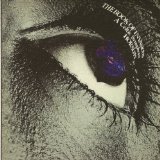 The promotion campaign for “Double Take” features some of the artists involved (Rod Stewart, Paul Carrack and Huey Lewis) talking about the first time they saw Frankie Miller. Now, that’s a great idea.
The promotion campaign for “Double Take” features some of the artists involved (Rod Stewart, Paul Carrack and Huey Lewis) talking about the first time they saw Frankie Miller. Now, that’s a great idea.
Freshers’ Week, Dundee University, 1976 and the first gig of the year was Frankie Miller’s Full House. I went to the gig with my new mate Steve (still a mate and writing great reviews for MusicRiot). The band were superb and we left the gig raving about Ray Minhinnet’s guitar work, Chrissy Stewart’s bass playing, but most of all about Frankie’s stunning soul voice. He started the ballad “With You in Mind” a cappella, and with perfect pitch, before the band dropped in underneath the vocal; I was completely hooked from that moment. I’ve seen an awful lot of gigs since then, but I’ve never heard a band that nailed it so completely, song after song.
So let me put “Double Take” into some kind of personal and historical context. As Frankie slowly fought back from the brink after a brain haemorrhage in 1994, you would hear occasionally from friends on the Scottish music scene about his progress; not frequently, but often enough to know that things were gradually improving, and it carried on like that until 2012 when word started to leak out that a project with Frankie’s old demo tapes was in progress. It’s taken over four years and probably a few unexpected twists and turns, but the final result is “Double Take”, nineteen unreleased Frankie Miller originals reconstructed from demo vocals, and all but one reimagined as duets with singers that wanted to be involved with the project. Although Frankie’s biggest chart hits (“When I’m Away From You” aside) were interpretations of other people’s songs, he also wrote a shedload of great songs for himself and other artists.
The nineteen songs on “Double Take” are pretty representative of Frankie’s songwriting output, covering soul, blues, rock, country and ballads. And that’s the staple diet of Scotland, right there; forget your deep fried Mars Bars. All of the songs have been arranged around the original demo vocals (with Frankie involved in quality control), but the quality of the voice is so good that almost everything sounds like a full-scale production. To be honest, given the choice, I’d rather listen to Frankie Miller demos than most singers’ finished product.
The guests on “Double Take” are a mix of megastars and people that Frankie knew and worked with in the past. Without listing the whole lot, how about Joe Walsh, Elton John, Kid Rock, Delbert McClinton, Kim Carnes and Willie Nelson. Add those to the ones listed at the top of the article and you’ve got a huge amount of respect across musical styles for Frankie’s work. Great news for fans of Frankie from the mid-seventies is that Full House appear on three songs in the middle of the album. “When It’s Rockin’” (with Steve Dickinson) is a horn-driven rocker, “Beginner at the Blues” (with Delbert McClinton) is a slow blues and “To Be With you Again” (with Kim Carnes) is a mid-tempo ballad. For a while there, I was back in that night in1976.
With so many songs and such a variety of arrangements, it’s difficult to pick standouts, but the gospel choir of “Where Do the Guilty Go” (with Elton John) and the country ballad “I Want to Spend My Life with You” (with Willie Nelson) are hard to beat, while the hauntingly simple “I Do”, with only Frankie’s vocal over a sparse arrangement is the perfect closer for the album.
This has been a long journey for some very dedicated people, culminating in an album that can only add to Frankie Miller’s legacy by bringing those powerful vocal performances to a wider audience and unearthing so many unreleased songs. This is a classic.
“Double Take” is out on September 30th on Universal.
Here’s a sneaky little peek for you:
 I’ve always been fascinated by the way a love of music can link episodes in your life, even when they have nothing else in common. When you meet someone and discover that you were at the same incredible gig years before or that you both love an obscure country, soul, blues or rock artist that no-one else has heard of. Or when you’re managing a venue and your entertainments manager tells you that he’s booked an artist for a St Patrick’s Day gig called Johnny Fean and you realise that it’s the Johnny Fean who played with Horslips twenty years earlier. Then, another fifteen years later you post something on a social network and the same Johnny Fean “likes” it. That’s the kind of link I mean and I want to tell you about the band and the album that triggered these coincidences.
I’ve always been fascinated by the way a love of music can link episodes in your life, even when they have nothing else in common. When you meet someone and discover that you were at the same incredible gig years before or that you both love an obscure country, soul, blues or rock artist that no-one else has heard of. Or when you’re managing a venue and your entertainments manager tells you that he’s booked an artist for a St Patrick’s Day gig called Johnny Fean and you realise that it’s the Johnny Fean who played with Horslips twenty years earlier. Then, another fifteen years later you post something on a social network and the same Johnny Fean “likes” it. That’s the kind of link I mean and I want to tell you about the band and the album that triggered these coincidences.
Horslips had released five albums before “The Book of Invasions – A Celtic Symphony” was released in April 1976. This was the first album the band recorded for Elton John’s label, DJM, and despite heavy promotion (including coloured vinyl singles) and good reviews, it only achieved an album chart position of 39 for one week in the UK. One of the reasons it’s so memorable for me is that it was part of the soundtrack for my “A” level revision through the long hot summer of 1976 (alongside Gallagher and Lyle’s “Breakaway”, Thin Lizzy’s “Jailbreak” and the Joe Walsh live album “You Can’t Argue with a Sick Mind”).
So, what makes the Horslips album a Closet Classic? The band had experimented with various permutations of rock, Irish folk and Celtic mythology on their previous albums, but it was on “The Book of Invasions” that everything gelled with the long-cherished idea of creating a classical symphony from these components. Just to wrap some context around “Invasions”, this was the era of the concept album when virtually every artist or band was trying to create a theme to link a few dodgy songs (yes, I do mean you Rick Wakeman) to create a pseudo-classical work.
Is it a symphony? Well, it’s split into three movements and it has a leitmotif which crops up throughout the album in various guises. “Daybreak” opens the album with the “Tá ‘na lá” (“It is day”) theme from a traditional Irish drinking song, in one of its many appearances, as a trumpet major key triad followed by a guitar harmonic version which leads into a harmony guitar version. before modulating into a more menacing minor key. And that’s just the first track. I’m not going to list all of the folk tunes used on the album because you can find them for yourself on the Horslips website; I’ll just say that it’s quite common on this album for a song to morph from a traditional ballad into a classic 70s riff-driven rock song.
If you’re looking for classic Celtic rock songs, then you’ll find plenty of those on this album. “Trouble (With a Capital T)”, “The Power and the Glory” and particularly “The Warm Sweet Breath of Love” (a dead ringer for the under-rated Thin Lizzy song “Running Back”) would all sound perfectly at home on “Jailbreak” which was released in the same month. But it’s not just the rock songs which work on “Invasions”; the folkier “The Rocks Remain”, “King of Morning, Queen of Day” and “Sideways to the Sun” (the story of the downfall of the Tuatha De Danann) and the instrumental interludes are all beautifully played.
I’m not saying “The Book of Invasions” is a perfect album, but it does have its perfect moments (the segue from “The Power and the Glory” to “The Rocks Remain”, for example), and at a time when everything can be found online, it would be a shame to miss this one. The scope of the album is quite breathtaking; Irish mythology rubs up against folk melodies, rock arrangements, symphonic themes, a huge range of instruments and bags of style to create a genuine classic album.
This album was the chart highpoint for Horslips in the UK and, although the subsequent “Aliens” and “The Man who Built America” were popular in the USA, the band split in 1980. Like many bands from this era, Horslips reformed for selected gigs in the noughties and can still be seen live occasionally. If you’re into rock or folk or both and you haven’t heard this before, you really should give it a listen especially after I’ve made it so easy for you.


